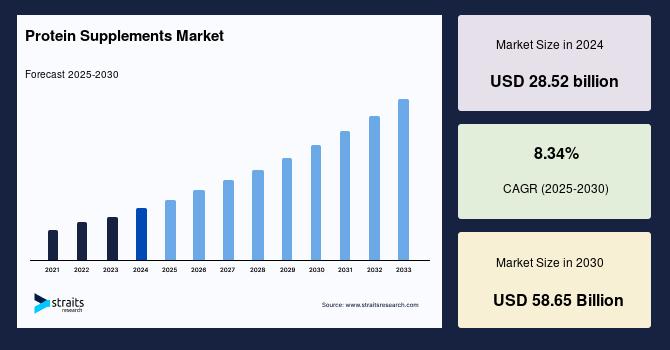Protein Supplements Market: Growth Trends, Drivers, and Forecast to 2033

The global Protein Supplements market size was valued at USD 28.52 billion in 2024 and is projected to reach from USD 30.90 billion in 2025 to USD 58.65 billion by 2033 at a CAGR of 8.34% from 2025 to 2033.
Market Drivers and Consumer Trends
The primary forces propelling the protein supplements market include rapidly evolving lifestyles and the expanding base of health-aware millennials who view protein supplementation as a convenient way to meet daily nutritional needs without added carbohydrates and fats. The uptake of protein supplements is especially pronounced among bodybuilders, athletes, and sports professionals who seek high-quality protein sources for muscle repair and enhancement.
Innovative product formats such as protein powders, bars, and ready-to-drink beverages have broadened the market. The rising trend of active lifestyles combined with heightened awareness of protein’s health benefits contributes significantly to the expanding consumer base. Additionally, increasing gym memberships and health club participation further stimulate demand. Chronic health concerns, notably among aging populations who face declining immunity and nutrient absorption issues, also contribute to market growth by driving consumers towards supplementation as a preventive measure.
Market Segmentation: By Product, Source, and Application
Animal-derived proteins dominated the protein supplements market, accounting for over 65% of revenue in 2021. These include whey, casein, egg, chicken, and beef proteins, known for their complete amino acid profiles. Whey protein, including isolates, concentrates, and hydrolysates, is particularly popular due to its high digestibility and muscle-building benefits. Hydrolyzed whey proteins command a premium price but are valued for faster absorption.
On the product front, protein powders held more than 60% of the market share, favored for muscle building, enzymatic and hormonal support, weight management, and tissue repair. Protein bars and other formats complement powders, appealing to on-the-go consumers.
In terms of application, the sports nutrition segment leads, contributing over 65% of market revenue. This segment is driven by athletes, bodybuilders, and sports enthusiasts who use protein supplements extensively for performance enhancement and recovery. Moreover, the convenience of purchase through online retailers, which accounted for over 30% of sales in 2021, alongside expanding supermarket and hypermarket offerings, facilitates wider accessibility and consumer reach.
Regional Market Insights
North America holds the largest share of the protein supplements market, accounting for more than 50% of revenue in 2021. The region benefits from heightened health awareness, a mature sports nutrition market, and high disposable incomes. Europe ranks as the second-largest market, with growing consumer focus on healthy lifestyles and increased demand for dietary supplements fueled by rising disposable incomes.
Asia-Pacific is the fastest growing market, projected to achieve a CAGR of 9.3% over the near term. Key growth factors include modernization, rising disposable income, and increased demand for convenient protein-rich snacks. Emerging economies like China and India are driving this growth via changing dietary habits and fitness trends.
Challenges and Opportunities
Despite strong growth, the protein supplements market faces challenges such as the high cost of animal-based proteins, leading manufacturers to explore more affordable plant-based protein alternatives like soy, pea, rice, and wheat. Plant-based proteins are gaining traction among consumers seeking sustainable and allergen-friendly options, opening avenues for innovation in ingredient sources and formulations.
Additionally, the market must contend with negative publicity and concerns regarding protein enhancement side effects, which could influence consumer perceptions. Price volatility of raw materials such as milk and soybeans also poses risks to manufacturers and supply chains.
Future Outlook
The future of the protein supplements market looks promising given ongoing product innovation, expanding consumer awareness, and growing adoption of fitness lifestyles globally. The rising incidence of chronic diseases coupled with aging populations will continue to fuel demand for protein-rich nutritional supplements for health maintenance. Expanding online retail channels and increasing supermarket presence in emerging and developed economies provide robust distribution platforms to capture market growth.
Manufacturers who invest in novel, sustainable, and functional protein sources with transparent labeling and health claims are likely to lead market expansion. The emphasis on clean-label products and plant-based ingredients will shape the next wave of growth in this dynamic market.
- Art
- Causes
- Crafts
- Dance
- Drinks
- Film
- Fitness
- Food
- Juegos
- Gardening
- Health
- Home
- Literature
- Music
- Networking
- Other
- Party
- Religion
- Shopping
- Sports
- Theater
- Wellness



